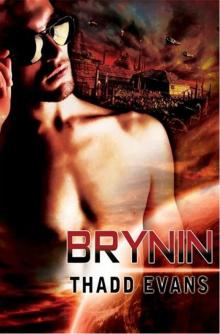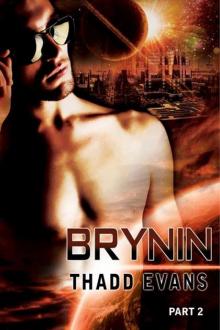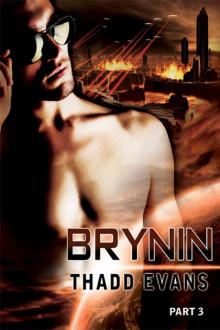- Home
- Thadd Evans
Brynin 1
Brynin 1 Read online
This is the story of a cloned man, the captain of a space transport ship, a freed slave, Jason_664.
In the distant future, The OTA Corporation, an organization that is spread across many planets, has created elite clones called the C. The C, the smartest humans that have ever lived, fly and maintain OTA's starships. This is the story of one of them, Jason 664, a freed slave, a man who longer has to work for OTA.
The unauthorized reproduction or distribution of this copyrighted work is illegal. Criminal copyright infringement, including infringement without monetary gain, is investigated by the FBI and is punishable by up to 5 years in federal prison and a fine of $250,000.
Please purchase only authorized electronic editions, and do not participate in or encourage the electronic piracy of copyrighted materials. Your support of the author's rights is appreciated.
This book is a work of fiction. Names, characters, places, and incidents either are products of the author's imagination or are used fictitiously. Any resemblance to actual events or locales or persons, living or dead, is entirely coincidental.
Brynin
Copyright © 2012 Thadd Evans
ISBN: 978-1-77111-072-3
Cover art by Angela Waters
All rights reserved. Except for use in any review, the reproduction or utilization of this work in whole or in part in any form by any electronic, mechanical or other means, now known or hereafter invented, is forbidden without the written permission of the publisher.
Published by Devine Destinies
An imprint of eXtasy Books
Look for us online at: www.devinedestinies.com
Brynin
By
Thadd Evans
Nan Serrins, my mother
"As ST7 approaches the speed of light, more deadly primary cosmic rays pass through the carbon nanotube hull. This is a problem for the co- pilot, Greg Thompson, myself, and any passengers."
Jason_664, Captain, pilot of starship ST7, a commercial transport.
Chapter One
Inbound
It was the year 1014 as the OTA Corporate Empire spread out over eight planets.
On screen, coordinates brightened. We were more than two light years beyond the edge of the OTA Empire.
Below the coordinates, the accelerometer indicated that ST7, our eighty foot long, thirty foot wide, tear drop shaped starship, was still maintaining a velocity of 157,203 miles per second.
Greg, a medium height, slender man with a narrow face entered the bridge and sat down. Greg, who had a doctorate in Astronomy, worked for OTA as a mapmaker. After seven years, he told his manager that he was tired of eighteen-hour days with little time off, and OTA fired him.
After speaking to OTA and Opco Corporation Human Resource managers, and OTA spacecraft captains at over six hundred locations, the only job he could find was working as my navigator. And since I was the sole proprietor of an independent company, a cargo starship shipping organization with no ties to OTA or Opco, hiring him wasn't a problem.
In addition to that, for several years, Greg had created spheroid holographic planispheres, three- dimensional star charts, navigational guides which were visible through an oval window. Every planisphere was different. Some contained the brightest stars. Others displayed comets, moons, asteroid belts and constellations. In every case, the observer could change the planisphere's latitude and longitude, making it possible for the current user to study charts more easily.
Because my ship wasn't following well-traveled OTA routes, most navigators were afraid of working for me. Several had told me that if ST7 broke down beyond Yopla, a distant planet, no one would rescue us. Luckily, Greg didn't care about that.
Near the top of his screen, aligned vectors, coordinates that were created when laser beams ricocheted off five distant planets, Yot, Minq, Nym, Bir, and Sios, returned to our ship, creating part of a galactic map. Although we used the vectors to make two and three-D maps, not all the beams came back. As a result, there were over 6,302,511 holes in the maps.
On many occasions, we filled many of them with less accurate ultraviolet and RGB scans. The problem with ultraviolet and RGB, red, green, blue light, was that the light itself curved as it passed Alpha Centauri A, Alpha Centauri B, Yot, Minq, two planets and six moons, Nasm, Caz, Onme, Ryet, Meis and Norom. Because of that, those distorted scans created faulty star charts.
Near the bottom of the screen, a tiny piece of asteroid dust whizzed by the port wing like a bullet.
Beyond that wing, just over 81 million miles from us, near the top of Alpha Centauri C, hot gases exploded, and shot toward us.
Greg said, a worried expression on his face, "If those hit ST7, the hull may burn up."
I shoved my hand through floating text and the ship veered starboard---missed the edge of the Dena asteroid belt by several feet. "If it wasn't for your vectors, we would have smashed into that belt."
"Thanks. Unfortunately, we're not out of trouble yet."
I blinked. "We're moving away from Alpha Centauri C."
Greg nodded.
On screen, an ultraviolet scan of the solar winds and Nooipl, a planet, and its magnetosphere, enlarged. The winds and the magnetosphere were spreading out. Steering through them would be more complicated.
In the center of a map, a cloud of asteroid dust, particles that were eleven miles from the port side, began moving toward the ship more quickly.
According to a Bayesian model, there was a 31 percent chance that the dust would hit us. However, these odds were based on old servers, computers that used sixty-one rows of poorly aligned mirrors.
I shoved my hand through text---sixteen statistical models appeared. "All these models are inaccurate because the servers are overloaded."
"It's the same old problem. We're up shit creek."
At the bottom of a monitor, the ship's servers were slowly recognizing recent probes of turbulent asteroid clouds, 877 exabytes of information.
Text warning flashed. Hard Drive Capacity Exceeded. Like before, its storage capacity had been reached. Right now, there were 451,000,000,000,000,000 bytes of data on it.
After comparing turbulence densities from two servers, a video of the ship's port side hull enlarged. Scratches covered every inch of the hull. Close to the edge of another screen, the starboard side brightened, making it easier to see.
From aft to the bow, most of the protective layering had been torn off. The entire hull would have to be resurfaced. However, the aging nanorobots, spider-like devices, might break down before they finished. In the past year, they removed paint more slowly because their conduits had been exposed to boiling and freezing temperatures.
I thought about the unfamiliar moon, Brynin, our next destination. Who lived there? I wasn't sure.
ST7 passed 14.1, the ninth planet in the R1 system and new coordinates along with videos appeared. Massive dry craters covered every square mile of 14.1, a lifeless planet. There weren't any towns or settlements. It was best to avoid it.
An unknown male voice came out my earplugs.
"Cap...Jaso...Wel..." The sound was replaced by white noise.
"Greg, did you hear what he was saying?" I frowned.
"Just a few words through my earplugs. But most of it was garbled." He blinked.
Near the edge of a screen, a video of P L Five, the planet that Brynin orbited, magnified. In the northern hemisphere, clouds moved across a vast ocean, one that was bordered by a long coastline. Close to an empty beach, 42.358N latitude -71.06W longitude, the tide rolled in. But the rest of the screen was empty. It was impossible to tell who lived close to the beach.
"Have you received any radio signals from P L Five?" I cleared my throat, worried.
"No. Although there are some distorted voices at two hundred-twenty Kilohertz
, they don't make any sense." His face tensed up as he leaned forward.
On screen, at 51.22N -51.44W, near the center of a vast ocean, there weren't any boats or ocean liners.
At the top of a monitor, behind our ship, the solar sail opened, and we began decelerating. If we slowed down too fast, ST7 would break apart.
"You'll watch the solar sail full time?" I paused. "For eleven minutes. Then I have to create newer vectors." He tightened one fist, concentrating.
"Understood."
An unfamiliar voice came out of my earplugs.
"This is Uma, calling from Brynin, the only safe moon left. LN warships have landed on the other moons, RO, Litor and M3."
Chills ran up my spine. "Greg, did you hear that?"
"Yes. Trouble. " He exhaled, ill at ease.
On screen, a nearby planet, 2.1, enlarged. Unfortunately, we didn't have enough tritium plasma engine fuel to get there.
The outside hull started heating up because we had just entered Brynin's outer atmosphere. At the same time, ST7's rate of deceleration increased.
Brynin was burnt orange, covered by deserts, mountains, and craters. It didn't have any oceans.
Greg scowled. "Six thousand two hundred miles to go before we reach this moon's only air terminal."
"Have you received the coordinates from Brynin?"
"Yes. Using an S.P. sequence right now," he said, referring to Standard Protocol, a system of measurements and ID's, ones used by four thousand humanoid races on many planets.
"Are the solar winds shifting drastically?" Greg always double-checked each moon or planet's magnetosphere and the surrounding solar winds because both shifted when they collided. If that shift were drastic, our ship would be thrown off course.
Although we had flown through those winds many times, each moon and planet affected the winds differently. Predicting exactly how each magnetosphere, a turbulent changing magnetic field, would push or break them apart was impossible.
At the top of a thermometer, temperatures increased. ST7's outside hull was white hot. The surface paint, the first layer of five, had just burned off.
"Tritium is low, at two point one percent." Greg shook his head, irritated. "Maneuvering through these winds has used up a lot more of it than I expected."
I nodded and bit my lip, frustrated. We had to reach Brynin, pick up passengers and cargo, and buy more tritium, an expensive fuel because there wasn't fuel left to head for D24 or any other planet, locations that were far away from the war.
Near the edge of the screen, the Utt desert, a location that was two hundred miles from Brynin's terminal, enlarged. Soon, it vanished, and was replaced by the Mein crater. At the edge of the crater, rocks started tumbling.
One at a time, one hundred eighty deserts appeared. All of them were empty, there wasn't a building in any of them. Each desert was a little over one thousand miles apart. Finding paying passengers, commercial cargo, and tritium on such a sparsely populated moon would be difficult.
On screen, dirt fell off a stovepipe-like cactus. The cactus faded, and the Brynin air terminal, a dome, replaced it.
A few hundred meters beyond the terminal, I noticed several curved towers, small pyramids and tiny domes, a place called Rawn, the only town on Brynin. Many of the buildings reminded me of Marira architecture, structures which resembled nautilus shells.
Close to several small pyramids, there was a row of cone shaped houses. Many of them were similar to ones on Red Ten, a planet inhabited by the Kindor, a powerful, yet peaceful race, a culture whose calendar was based on the Eis Ocean tides.
Not far away, the KE had erected octagon shaped homes close to dirt roads. Then I remembered that the KE, a brutal race that was known for their desire to conquer their neighbors, lived on Moon 21. According to their Prophet, Aot, every crater was sacred.
Beyond the octagons, a small spacecraft flew over a few Lor huts. On Indigo 3, a planet, after forty-one years of war, the Lor, a race that preferred compromise, had signed a treaty with the Shiy. Despite the treaty, both races still argued about who owned the Beuif Forest.
Within moments, several round towers and a few triangular shaped houses, all Aito and Qoowo architecture, enlarged.
According to a recent database, most Qoowo were miners. Wanting to find jobs, they had moved to Moon 21.
Because we had been to Red Ten, Moon 21 and Indigo 3, I knew that our ship, a Series 7, was rare. It could travel between planetary systems. Most of the ships on Brynin were probably Series 1 or 2, only used for transport between the surrounding moons and P L Five. Both 1 and 2 used degraded level D tritium rather than the high level A tritium. Although we needed level A, it might be impossible to locate any.
A miniature three dimensional cross section of ST7's globe shaped bridge appeared, and began rotating, making it easier for me to find out if Brynin's gravity would tear off our muscles.
As the engine roared louder, our ship's interferometric telescopes scanned the terminal's servers. At the same time, Brynin's 61 TCP-like protocols scrolled, indicating that their servers used eleven different computer platforms, barely adequate for our needs.
A man's voice came out of my earplugs.
"Can...u...Ou..."
It was distorted, meaningless. Our software would have to reconfigure ST7's 201 servers or we couldn't understand what the terminal's interstellar traffic controllers were telling us.
Our landing coordinates, brightened. After several reconfigurations, the terminal's servers had recognized our TCP.
A video of the terminal's only runway enlarged. If this runway was too thin, our ship would land, tip over and break apart.
Greg complained, "Density ratios are not available."
I nodded. It was impossible to tell if this airstrip would support ST7's weight.
Not far from the terminal, alongside oblong interstellar craft, all of them parked in designated areas, several humanoids in sepia jackets started walking.
A feminine voice named Verra, ST7's response for using the on board bacteria and virus scanning applications, began speaking in a monotone, the way she always did. Jason, which mode? Default is voice.
"Voice."
That mode is functioning.
"Xyz axis. 0,0,0...16,0,0...16,16,0...0,16,0, default box one." I placed my hand on my clenched fist, thinking. "Rotate box one three times horizontally. Retain default RGB at six hundred percent size, one hundred percent opaque. Default resolution. Center box six thousand fifteen around two B110 beings on the bridge. Combine scans five and six, studies of bacteria and viruses for more in depth analysis.
Hologram of default box six thousand fifteen will be available in one point four seconds. Double check RGB, visible light, screen for changes.
I hesitated. "No changes."
Close to us, the edge of a semi-transparent holographic box rose out of the floor. Soon the box surrounded us. Now we were in a simulated desert, a three-dimensional landscape. Much to my surprise, a semi-transparent onyx colored bird swooped down, ending up near the end of a branch. It turned opaque, making it easier for us to examine this species. Beneath nearby sand, amoebas enlarged.
There are over six million amoebas and four hundred thousand paramecium per square inch at this location.
All of them are carrying five strains of encephalitis. The center of this holographic box is exactly six miles due north of the Brynin terminal.
As replicas of several tiny stovepipe cacti, all of them a few miles from us, brightened, I remembered nine mutated typhoid strains, diseases that would kill a Qoowo, a Turon humanoid, or a human in one minute. In my mind's eye, on Moon 21, a fly crawled across a Qoowo male corpse. He had been killed by mutated typhoid.
Eleven feet beneath the adjacent sand, five typhoid strains are multiplying at an exponential rate.
I remembered the emaciated faces of two dead Aito male humanoids from the planet, Faraw11. Their galactic craft had touched down on a desert oasis. Soon after, they drank water from a well
and died of typhoid poisoning.
Scanning for E. coli 0157-H7, Campylobacter jejuni, Salmonella, Staphylococcus aureus C, Listeria tricytogenes, Clostrium perferfringens, Vibrio Vlunificus, Hepatitis A virus, Norwalk and five similar types of viruses within a one hundred by one hundred meter wide area, 91.228N latitude, -151.06W longitude. Red, green, blue, visible light scan available in five seconds.
"Okay." Without warning, my body slammed forward as our rate of deceleration increased.
EFS, the Electro Magnetic Field setting, has just changed.
Greg blurted, "I wish EFS had kicked in faster. My head jerked forward so hard that it almost tore off!"
The bridge started rotating. Now our feet were aimed toward Brynin, making it easier for our bodies to adapt to this moon's gravity.
Strains E. coli 0157-H7, Campylobacter jejuni, Salmonella, Staphylococcus Aureus C, Listeria Tricytogenes, Clostrium perferfringens, Vibrio Vlunificus, Hepatitis A virus, are two hundred feet beneath a nearby granite rock.
"Greg, do you think any of the bacteria or viruses she mentioned are a threat?"
"No. But let's scan five more locations, two thousand miles apart."
"I just initiated one. Five vectors are fanning out from this location, using a default spread until all of them are two thousand miles apart. Retain prior scanning sequence."
First CS hologram available in two point one seconds.
"Okay." I wiped sweat off my forehead.
A CS, a Cross Section hologram, the result of an extreme x-ray, materialized. Beneath replicas of desert grasses and stovepipe-like cactuses, I noticed trace amounts of Cholera.
Next to the cactus, a four-inch long magenta lizard crawled over a rock and hissed. Not far away, a turquoise Erin bird flapped its wings.
The lizard, a member of the Leali species, is poisonous. If you eat it, neurotoxins will attack your front lobe and you will die within two days.

 Brynin 1
Brynin 1 Brynin2
Brynin2 Faasp Hospital
Faasp Hospital Brynin 3
Brynin 3